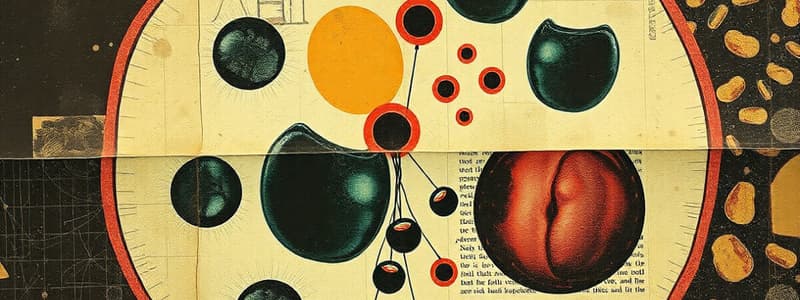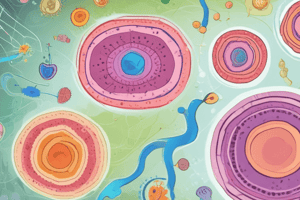Podcast
Questions and Answers
Which of the following cellular components is found in both prokaryotic and eukaryotic cells?
Which of the following cellular components is found in both prokaryotic and eukaryotic cells?
- Nucleolus
- Ribosomes (correct)
- Lysosomes
- Mitochondria
What is the primary role of the rough endoplasmic reticulum (rER) in protein transport?
What is the primary role of the rough endoplasmic reticulum (rER) in protein transport?
- Lipid synthesis and detoxification
- Energy production through cellular respiration
- Waste breakdown and cellular recycling
- Protein synthesis and modification (correct)
During fertilization in mammals, what is the main function of the acrosome reaction?
During fertilization in mammals, what is the main function of the acrosome reaction?
- To release enzymes that digest the zona pellucida, allowing the sperm to penetrate the egg (correct)
- To block polyspermy by hardening the zona pellucida
- To provide the sperm with energy for its journey to the egg
- To trigger the cortical reaction in the egg
Which process during meiosis leads to the greatest increase in genetic variation within a population?
Which process during meiosis leads to the greatest increase in genetic variation within a population?
A cell in the growing root tip of a plant contains 16 chromosomes. How many chromosomes will each daughter cell contain after mitosis?
A cell in the growing root tip of a plant contains 16 chromosomes. How many chromosomes will each daughter cell contain after mitosis?
Which characteristic distinguishes totipotent stem cells from pluripotent stem cells?
Which characteristic distinguishes totipotent stem cells from pluripotent stem cells?
In the context of the lac operon, what happens when lactose is present in the environment of a bacterial cell?
In the context of the lac operon, what happens when lactose is present in the environment of a bacterial cell?
A plant with a specific genotype for height grows taller in a sunny environment compared to a shady environment. This difference illustrates which concept?
A plant with a specific genotype for height grows taller in a sunny environment compared to a shady environment. This difference illustrates which concept?
Flashcards
Cell
Cell
Basic structural and functional unit of all known living organisms.
Ribosome
Ribosome
Organelle responsible for protein synthesis; can be free or attached to the rER.
Rough Endoplasmic Reticulum (rER)
Rough Endoplasmic Reticulum (rER)
Organelle involved in the synthesis and transport of proteins.
Golgi Apparatus
Golgi Apparatus
Signup and view all the flashcards
Locus
Locus
Signup and view all the flashcards
Mitosis
Mitosis
Signup and view all the flashcards
Stem Cell
Stem Cell
Signup and view all the flashcards
Phenotype
Phenotype
Signup and view all the flashcards
Study Notes
- All living organisms consist of cells with shared characteristics.
Eukaryotic Cell Ultrastructure
- Eukaryotic cells contain a nucleus, nucleolus, ribosomes, rough and smooth endoplasmic reticulum, mitochondria, centrioles, lysosomes, and Golgi apparatus.
Protein Transport
- The rough endoplasmic reticulum (rER) and the Golgi apparatus facilitate protein transport within cells.
- They play a role in the formation of extracellular enzymes.
Prokaryotic Cell Ultrastructure
- Prokaryotic cells feature a cell wall, capsule, plasmid, flagellum, pili, ribosomes, mesosomes, and circular DNA.
- Organelles listed in point 3.2 can be recognized in electron microscope (EM) images.
Mammalian Gametes
- Mammalian gametes are specialized for specific functions.
- Sperm: Acrosome
- Egg: Zona pellucida
Fertilization in Mammals
- Fertilization includes the acrosome reaction, the cortical reaction, and the fusion of nuclei.
Gene Location
- Locus = location of genes on a chromosome.
- Loci = plural of locus
- Genes on a chromosome are linked, including sex-linked genes.
Meiosis
- Meiosis ensures genetic variation through the production of non-identical gametes.
- Via independent assortment of chromosomes
- Via crossing over of alleles between chromatids
- Details of meiosis stages are not required.
Mitosis
- Mitosis and the cell cycle produce identical daughter cells.
- Important for growth and asexual reproduction.
Core Practical 5
- Prepare and stain a root tip squash to observe the stages of mitosis.
Stem Cells
- Stem cell: Understand the terms stem cell, pluripotency and totipotency.
- One must be able to discuss how society uses scientific knowledge to make decisions about use of stem cells in medical therapies.
Cell Specialization
- Cells become specialized through differential gene expression.
- Active mRNA is produced > leads to protein synthesis
- Proteins control cell processes or determine cell structure in animals and plants
- Includes the lac operon
Multicellular Organisation
- Cells of multicellular organisms are organized as follows: tissues into organs and organs into systems.
Phenotype
- Phenotype results from the interaction between genotype and the environment.
Epigenetic Changes
- Epigenetic changes (DNA methylation, histone modification) can modify gene activation.
- Epigenetic changes can be passed on following cell division.
Polygenic Inheritance
- Some phenotypes are affected by multiple alleles for the same gene at many loci (polygenic inheritance) and the environment.
Studying That Suits You
Use AI to generate personalized quizzes and flashcards to suit your learning preferences.





